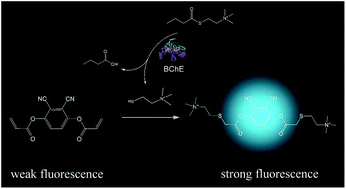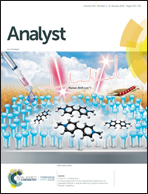Thiol–ene click reaction-induced fluorescence enhancement by altering the radiative rate for assaying butyrylcholinesterase activity†
Abstract
Butyrylcholinesterase (BChE) generally acts as an important plasma biomarker for clinical diagnosis due to its major contribution to human plasma cholinesterase levels, but its current fluorometric assay relying on fluorogenic substrates frequently suffers from the lack of sufficiently fast response time and specific recognition of substrates relative to the traditional Ellman's method. In this work, we report a fluorescent molecular probe for assaying BChE activity based on thiol-triggered fluorescence enhancement via thiol–ene click reactions. A low-temperature experiment and theoretical analysis exclude the possibility of weak fluorescence of the probe caused by an intramolecular photoinduced electron transfer process and support the main cause of an ultraslow radiative rate due to the introduction of two acrylyl groups. This probe has sensitive fluorescence responses to thiols via thiol–ene click chemistry, and it can distinguish between glutathione and cysteine or homocysteine in different emission colors. The rapid reaction kinetics of this probe enables it to monitor hydrolysis reactions catalyzed by butyrylcholinesterase (BChE) in a real-time manner. This probe is used to develop the first fluorometric assay of BChE activity based on fluorescence enhancement triggered by thiol–ene click chemistry using butyrylthiocholine as the substrate. The established BChE assay shows excellent sensitivity, and is capable of avoiding the interference from glutathione and acetylcholinesterase (AChE) in a complex matrix. The inhibition test of tacrine on BChE with this assay substantiates its feasibility in screening potential inhibitors of BChE. This work demonstrates a design strategy of fluorescent probes lighted up by thiol–ene click reactions, reveals the main cause of thiol-triggered fluorescence enhancement by altering the radiative rate, and provides the first fluorometric assay of BChE based on rapid thiol–ene click reactions.

- This article is part of the themed collection: Optical Biosensor Devices


 Please wait while we load your content...
Please wait while we load your content...